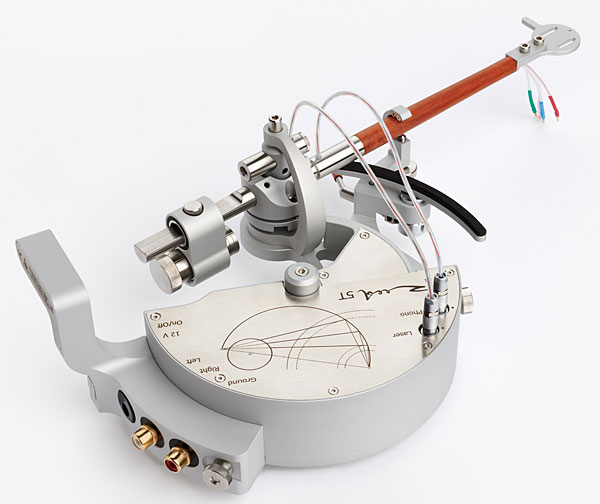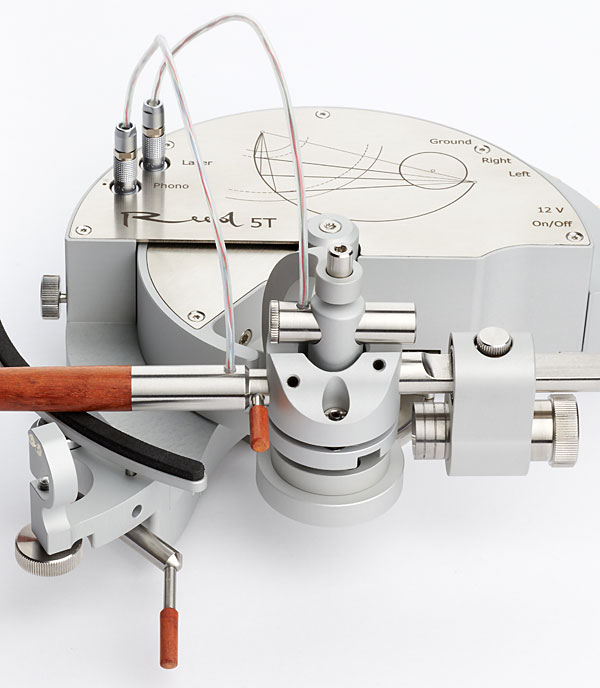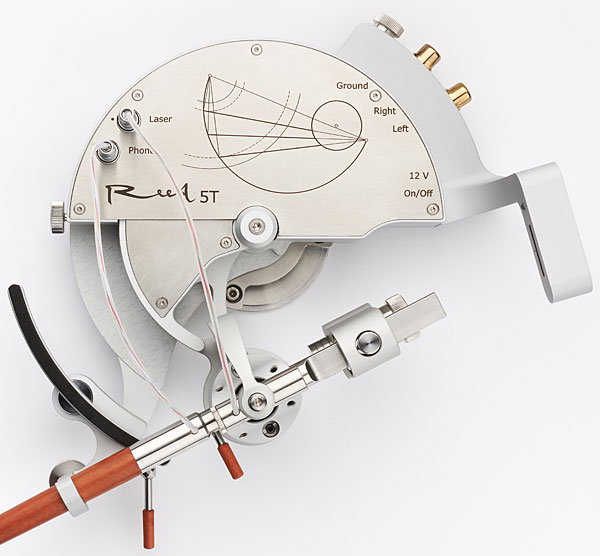| Columns Retired Columns & Blogs |
I might have missed it, but was the SAT mounted on the Muse 1C or your Caliburn? One thing's for sure: the 5C is a most ingenious arm. Thanks for the excellent review.
The 5T's horizontally positioned pivot points, which control vertical movement, can each be adjusted to set azimuth to ±8°. And the entire arm mechanism rides up and down on a threaded post, allowing precise ±0.2mm vertical tracking angle and stylus rake angle adjustment. In addition, the wooden arm tube is user-replaceable, which allows you to change the tonearm's effective mass or swap out cartridges premounted on extra tubes.
Stable, timbrally neutral sound
I can't separate the arm's performance from the 'table's (I'd love to try the 5T on my Continuum Audio Labs Caliburn turntable), so let's talk about the combination. The 1C and 5T did really well on the tap test—better than many "fancy feet"–equipped 'tables. Tapping anywhere on the plinth produced the tiniest of "tinks," with no low-frequency component and no overhanging sound. Tapping on the HRS base produced a somewhat lower frequency "tink," but still nothing compared to the sounds produced on some more massive 'tables.
I'd pulled out the Modern Jazz Quartet's European Concert (Atlantic SD 2-603) to show Ken Micallef for the video he recently shot of me for his YouTube channel. Well-recorded in Sweden in 1960, the MJQ record provides a good test for image stability, transient clarity, bass extension, and soundstaging.
All across side one, the Reed produced a consistently wide soundstage with stable, unwavering, and cleanly drawn three-dimensional images: John Lewis's piano, left channel; Milt Jackson's vibes, right; drummer Connie Kay and bassist Percy Heath, centerstage. Over the decades I've played it, this difficult-to-reproduce record just keeps sounding better! Apparently, what I once thought were recording distortions in the piano and vibes were actually tracking issues—rendered virtually undetectable with the 5T in place.

On "I Should Care," Kay's cymbals had the ideal sharp, metallic ring and natural sizzle and decay. The snare was equally snappy, with no overhang, each hit cleanly evaporating into black. Percy Heath's compact bass lines combined well–articulated-and-textured transient "pop" with generous "live space" sustain and decay that produced tuneful, nimble rhythmic swing—all this on a record that can show sloppy low-frequency overhang on lesser 'tables and arms. Images were properly sized, well-focused and neither bloated nor diffuse—ill effects some air-bearing tangential trackers create.
The 5T extracted musical fun from every record I played, plus a sense of ease and relaxation. It did everything well. Its overall performance was, top to bottom, timbrally well-balanced, "musical," and artifact-free: sweet yet detailed and open and airy like the 3P I reviewed a few years ago.
This tangential tracker especially excelled in soundstage stability and expansiveness, all across the record surface, consistently. Tracking-error distortions are not heard as "distortion" in the classic sense: With a properly-set-up pivoted arm, there's no "buzzing" or gross mistracking; if you hear that, you've made a serious setup mistake. Rather, it's heard to a great degree as second-order harmonic "fuzziness," particularly at soundstage center.
On this familiar live recording, I noticed an unusually well-balanced curtain of applause spread across the stage. Image focus and especially transient clarity were consistent throughout the soundstage and across the entire record side.
Playback on the reference SAT CF1-09 arm (using the Ortofon MC Anna Diamond cartridge—which, while not identical, is very similar to the MC Century), which alone costs more than the Reed 1C and 5T combined, generally produced a more subtle picture, yet it surprised by better expressing the vibe's shimmering, mesmerizing vibrato, which the Reed somewhat shortchanged. With the SAT setup, the entire picture hung onto the decay far longer, and the bass weight was no contest—SAT for the easy win. The sheer bottom-end grip and force produced a deeper stage that placed the drum kit farther back and behind the bass. That bottom-end grip also added hall-sound perspective and brought greater power to Heath's bass lines, particularly on the Arco bass that ends the track.

For a serious test of the Reed 5T's efficacy, I used Fiesta in Hi-Fi (Mercury SR 90134), side one of which is cut almost to the label. The SAT arm's geometry uses Löfgren alignment, though that assumes that the innermost groove radius is 75mm, which is optimistic: On this record, I measured modulated grooves to within 56mm of the record center! Beyond the second null point, which falls at 80.66mm, distortion rises rapidly.
Is it audible? The side ends with Ron Nelson's rousing "Savannah River Holiday," and here again there was no contest, but with a different winner. The Reed 5T remained focused to the very end of the side, with a wide stage upon which each instrument was cleanly delineated. You'd never know you were at the end of the side, especially one cut so close to the label. It was remarkable, and far superior to more typical tangential trackers, which usually produce "tail wagging the dog" spatial wavering. The SAT produced in the post-null space a narrower stage on which the instruments were soft and smeared. It only lasted a short time and was neither unpleasant nor distorted-sounding. It just seemed degraded compared to most of the side. The 5T was clearly superior here.
That experience drove me to play the test pressing of the D2D Bruckner 7 I've previously written about, which should be out by the time this column is published. The Reed 1C/5T combo killed (in the good sense) on this simply miked record, producing airy, smooth violins and violas and giving proper weight to the double basses, rumbling timpani, and, at the end of the first movement, a majestic presentation of the horns—plus a grand sense of the Berlin Philharmonie space.

Conclusion
For less than $40,000, you can get the combination of the Reed Muse 1C—a handsome, well-designed, dual-friction-drive (or belt-drive), high-performance turntable—and the 5T tonearm, an ingeniously designed, tangential-tracking arm that delivers what it promises for playback—spatially, dynamically, and timbrally. The 1C plays at accurate and consistent speed. It is quiet and well-isolated from the outside world, and it passes the "tap test" better than many other turntables do.
As for the 5T tonearm, I'd say you can get better bottom-end performance from less costly arms such as Graham's Phantom Elite, perhaps because the Reed arm isn't grounded to the plinth but is instead riding on the tangential merry-go-round. But what the 5T arm does so well—especially spatially and without the usual tangential hassles—makes it special, an object of desire for vinyl lovers lucky enough to hear it.
Writing instruction manuals might not be his forte, but Mr. Triukas has designed a brilliant turntable and tonearm in the 1C and 5T, respectively, and somehow manages to produce them for a price that won't break many high-end banks.

I might have missed it, but was the SAT mounted on the Muse 1C or your Caliburn? One thing's for sure: the 5C is a most ingenious arm. Thanks for the excellent review.

I'd guess it's tough then to make any definitive comparisons between the performance of the Reed arm/turntable versus that of the SAT/Caliburn: different turntable, different arms, different cartridges (even if both are Ortofons). It would be quite interesting to hear how the Reed 5T (Klaatu barada nikto!) would perform mounted on the Caliburn, if possible.
If I'm not mistaken, the Caliburn uses vacuum clamping. In my experience, vacuum hold-down makes a significant improvement in the performance of any tonearm, given that it presents the arm with the flattest, firmest surface possible. It's certainly a feature that I'd never again live without. So the 5T on the Caliburn might be a real blockbuster!

I had to laugh at the arm the first time I saw a picture of it. How the hell does that thing track with the cables coming out of the top of the wand? was my first thought...lol!
Then I read how it operates. Brilliant idea and only to be improved upon as time goes by. Watch the TT R&D budgets climb at companies interested in gaining that information. :)

"The 1C plays four speeds: 16.67, 33.3, 45, and 78. The 78rpm setting can be adjusted to between 70–85rpm to accommodate the various speeds appropriate to different 78rpm records."
hr

Up until this past few days, I could have told ya how to set the anti-skating for this baby. Now? Not so much!
I know it's all about the sound, but this baby exudes fine fit 'n finish with its looks, too!

I remember seeing and hearing this Reed design on a Reed Muse 3C turntable in an ultra-high-end demo (Zellaton Reference MkII speakers driven by YS Sound monoblocks, at the High End Munich Show in 2019. Impressive.